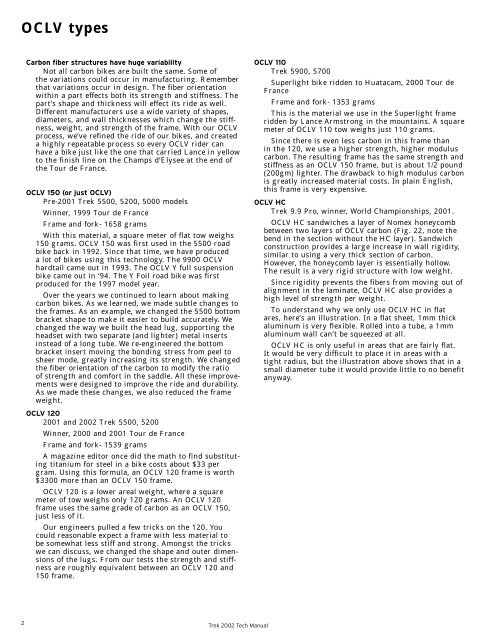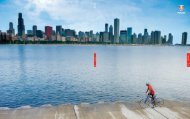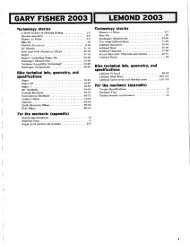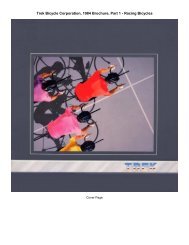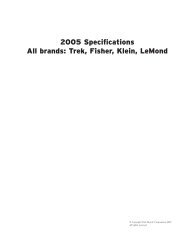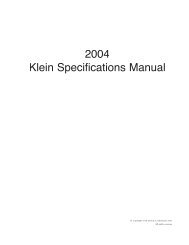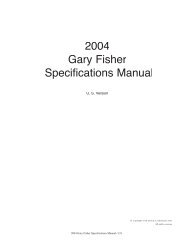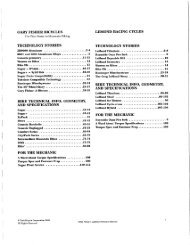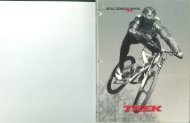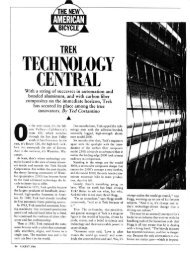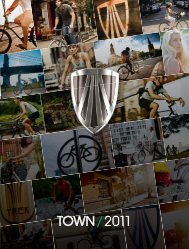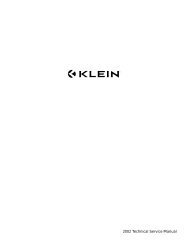TECHNOLOGY STORIES BIKE INFO, GEOMETRY ... - Vintage Trek
TECHNOLOGY STORIES BIKE INFO, GEOMETRY ... - Vintage Trek
TECHNOLOGY STORIES BIKE INFO, GEOMETRY ... - Vintage Trek
Create successful ePaper yourself
Turn your PDF publications into a flip-book with our unique Google optimized e-Paper software.
OCLV types<br />
2<br />
Carbon fiber structures have huge variability<br />
Not all carbon bikes are built the same. Some of<br />
the variations could occur in manufacturing. Remember<br />
that variations occur in design. The fiber orientation<br />
within a part effects both its strength and stiffness. The<br />
part’s shape and thickness will effect its ride as well.<br />
Different manufacturers use a wide variety of shapes,<br />
diameters, and wall thicknesses which change the stiffness,<br />
weight, and strength of the frame. With our OCLV<br />
process, we’ve refined the ride of our bikes, and created<br />
a highly repeatable process so every OCLV rider can<br />
have a bike just like the one that carried Lance in yellow<br />
to the finish line on the Champs d’Elysee at the end of<br />
the Tour de France.<br />
OCLV 150 (or just OCLV)<br />
Pre-2001 <strong>Trek</strong> 5500, 5200, 5000 models<br />
Winner, 1999 Tour de France<br />
Frame and fork- 1658 grams<br />
With this material, a square meter of flat tow weighs<br />
150 grams. OCLV 150 was first used in the 5500 road<br />
bike back in 1992. Since that time, we have produced<br />
a lot of bikes using this technology. The 9900 OCLV<br />
hardtail came out in 1993. The OCLV Y full suspension<br />
bike came out in ‘94. The Y Foil road bike was first<br />
produced for the 1997 model year.<br />
Over the years we continued to learn about making<br />
carbon bikes. As we learned, we made subtle changes to<br />
the frames. As an example, we changed the 5500 bottom<br />
bracket shape to make it easier to build accurately. We<br />
changed the way we built the head lug, supporting the<br />
headset with two separate (and lighter) metal inserts<br />
instead of a long tube. We re-engineered the bottom<br />
bracket insert moving the bonding stress from peel to<br />
sheer mode, greatly increasing its strength. We changed<br />
the fiber orientation of the carbon to modify the ratio<br />
of strength and comfort in the saddle. All these improvements<br />
were designed to improve the ride and durability.<br />
As we made these changes, we also reduced the frame<br />
weight.<br />
OCLV 120<br />
2001 and 2002 <strong>Trek</strong> 5500, 5200<br />
Winner, 2000 and 2001 Tour de France<br />
Frame and fork- 1539 grams<br />
A magazine editor once did the math to find substituting<br />
titanium for steel in a bike costs about $33 per<br />
gram. Using this formula, an OCLV 120 frame is worth<br />
$3300 more than an OCLV 150 frame.<br />
OCLV 120 is a lower areal weight, where a square<br />
meter of tow weighs only 120 grams. An OCLV 120<br />
frame uses the same grade of carbon as an OCLV 150,<br />
just less of it.<br />
Our engineers pulled a few tricks on the 120. You<br />
could reasonable expect a frame with less material to<br />
be somewhat less stiff and strong. Amongst the tricks<br />
we can discuss, we changed the shape and outer dimensions<br />
of the lugs. From our tests the strength and stiffness<br />
are roughly equivalent between an OCLV 120 and<br />
150 frame.<br />
<strong>Trek</strong> 2002 Tech Manual<br />
OCLV 110<br />
<strong>Trek</strong> 5900, 5700<br />
Superlight bike ridden to Huatacam, 2000 Tour de<br />
France<br />
Frame and fork- 1353 grams<br />
This is the material we use in the Superlight frame<br />
ridden by Lance Armstrong in the mountains. A square<br />
meter of OCLV 110 tow weighs just 110 grams.<br />
Since there is even less carbon in this frame than<br />
in the 120, we use a higher strength, higher modulus<br />
carbon. The resulting frame has the same strength and<br />
stiffness as an OCLV 150 frame, but is about 1/2 pound<br />
(200gm) lighter. The drawback to high modulus carbon<br />
is greatly increased material costs. In plain English,<br />
this frame is very expensive.<br />
OCLV HC<br />
<strong>Trek</strong> 9.9 Pro, winner, World Championships, 2001.<br />
OCLV HC sandwiches a layer of Nomex honeycomb<br />
between two layers of OCLV carbon (Fig. 22, note the<br />
bend in the section without the HC layer). Sandwich<br />
construction provides a large increase in wall rigidity,<br />
similar to using a very thick section of carbon.<br />
However, the honeycomb layer is essentially hollow.<br />
The result is a very rigid structure with low weight.<br />
Since rigidity prevents the fibers from moving out of<br />
alignment in the laminate, OCLV HC also provides a<br />
high level of strength per weight.<br />
To understand why we only use OCLV HC in flat<br />
ares, here’s an illustration. In a flat sheet, 1mm thick<br />
aluminum is very flexible. Rolled into a tube, a 1mm<br />
aluminum wall can’t be squeezed at all.<br />
OCLV HC is only useful in areas that are fairly flat.<br />
It would be very difficult to place it in areas with a<br />
tight radius, but the illustration above shows that in a<br />
small diameter tube it would provide little to no benefit<br />
anyway.


